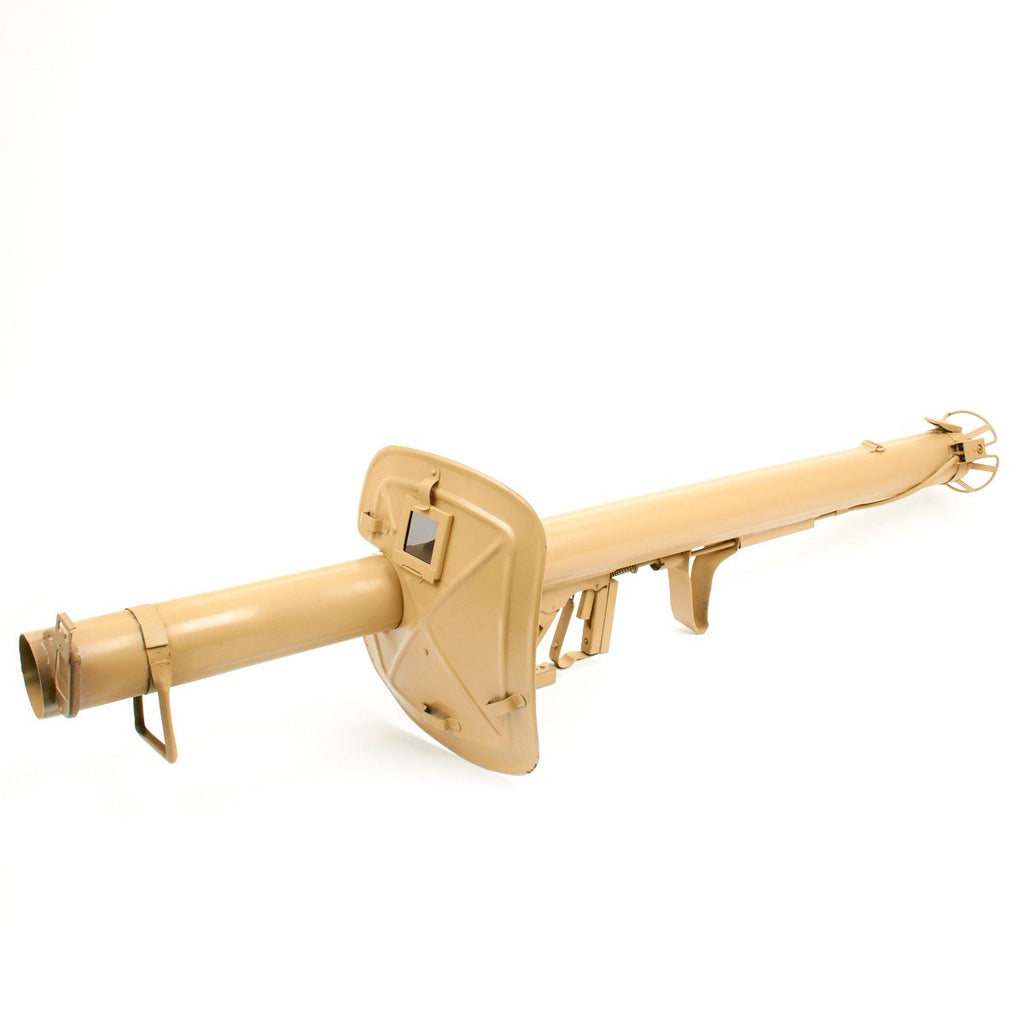Item Description
New Made Item: Display Only, this launcher is totally inert and cannot be converted to an explosive device. It is in full compliance with guidelines provide by the BATF. Not Available for export.
An IMA exclusive! For a few years awful reproductions were available, so we decided to exclusivity manufacture our own non-functioning reproduction of the legendary Panzerschreck. It was copied directly from an original in the IMA collection.
This is a stunning reproduction of one of the most iconic WWII anti-tank weapons and will become the centerpiece of any world war two collection. This item requires no type of license as it is totally inert and incapable of ever being converted to an explosive device.
Features include exact 1:1 scale, measuring 66 inches (5' 6") in length, correct color dunkelgelb paint, and a "fluted" RPzB 54 steel barrel tube to increase strength. It also has a complete reproduction shield with glass view window, sights, trigger assembly, and inert ignition system. Muzzle guard bar on front prevents damage to the muzzle of the tube. This guard is only held in place by friction, so it may be movable.
History of the Panzerschreck RPzB.54- The RPzB 43 Panzerschreck (Tank Terror) was an enlarged version of the U.S. M1 Bazooka being scarcely more then a length of steel tube with a shoulder rest and firing arrangements attached, hence the alternative German nickname of Ofenrohr (Stovepipe). The caliber was selected simply because 88mm hollow charge warheads were already in production for launching from the R-Werfer 43 but with rockets for the RPzB 43 there was a difference. Having noted that the American M6 HEAT rocket was ignition method was altered accordingly, resulting in the RPzBGr 4322 weighing 3.25kg (7.2lb). However the Germans decided not to adopt the battery-powered ignition circuitry rapidly developing and adopting a magneto-driven ignition method. It is interesting to note that the Americans later adopted a magneto ignition system for their M9/M9A1 launchers.
The unexpected advent of the M1 Bazooka in Tunisa made a considerable impact on the German military establishment. Not only did the Bazooka concept present a considerable danger to German armor but the simplicity, low cost and potential of the launchers design made a great impression. The immediate result was the abandonment of the R-Werfer 43 in favor of the novel Bazooka rocket delivery system. Within weeks the first examples of the 88mm (3.4in) Raketenpanzerbüchse43 (88mm RPzB 43) were coming off the HASAG production line at Meuselwitz. Most R-Werfer 43's already produced were sent to Tunisia or Italy and were soon forgotten or lost in action. Many were diverted and placed among the defensive works covering the Normandy beaches as part of the Atlantic Wall defenses.
The weight of a loaded 88mm RPzB 43 was 9.5kg (20.9lb). Amour penetration performance remained as before ie 160mm (6.24in) of amour plate set at an angle of 60°. The length of the RPzB 43 (1.64m) meant that to handle it effectively called for a team of two, one acting as the loader and carrying five ready-use rockets on a special backpack frame. Only when a target approached was a rocket loaded into the rear of the launching tube where it was held by a retaining catch and connected by the loader to the firing circuit via two thin wires. The firer used simple fixed sights for aiming and cocked the firing arrangements by pulling back a spring-loaded lever. Operating the trigger produced a current for a primer to ignite the rocket motor and launch the rocket.
RPzB 43 teams had to be masters of concealment and stealth for the practical range of the RPzBGr 4322 rocket was a maximum of 150m (492ft). Combat ranges were frequently considerable less. A trained team could launch four or five rockets in one minute. Panzerschreck warheads were also highly effective against field fortifications or buildings during fighting in built up areas.
The RPzB 43 was very rapidly accepted into service and soon became the preferred portable anti-tank weapon for infantry formations. By 1944 the weapon was so well integrated that each infantry regiment had an establishment of 36 held by the regimental anti-tank company, along with three 75mm (2.9in) Pak 40 towed anti-tank guns. The so-called Volksgrenadier infantry regiments of the latter war years were meant to have a planned 72 Panzerschrecken.
By mid-1944 the RPzB 43 was well into the process of being withdrawn from front line units in favor of the improved 88mm (3.4in) RPzB 54. The RPzB.54 Panzerschreck antitank rocket launcher differs from the Ofenrohr primary by addition of the protective steel shield with aiming glass window, which protects shooter"s face and hands from rocket back blast. Another improvement is more elaborate sight, which allows for better windage, temperature and range adjustments, as well as the addition of 4 steel "flutes" which run the length of the barrel and increased strength.
By 1944 the Panzerschreck series had already become so important that production was in progress in seven centers and many others were concerned with sub assemblies. The simplicity of the RPzB 54 and its lack of demand for critical raw materials or manufacturing resources were such that it became an integral weapon in the German effort.
- This product is not available for international shipping.
- This item is completely legal within the USA. International Military Antiques, Inc observes all Federal, State and Local laws. Everything for sale on ima-usa.com is completely legal to own, trade, transport and sell within the United States of America. This display launcher has been engineered to be inoperable according to guidelines provided by the US Bureau of Alcohol, Tobacco, Firearms and Explosives (BATF).
- Not eligible for payment with Paypal or Amazon































